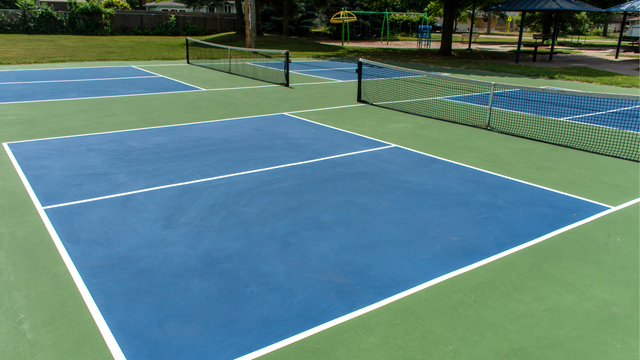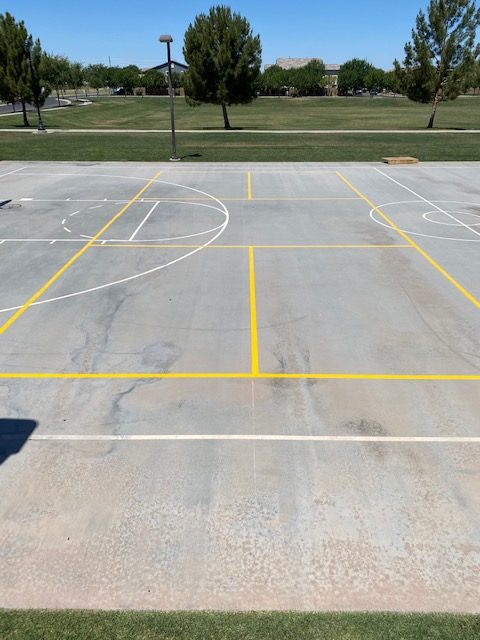Why Buying a Skilled Pickleball Court Contractor is Essential for Your Sports Complex
Why Buying a Skilled Pickleball Court Contractor is Essential for Your Sports Complex
Blog Article
A Comprehensive Overview to Designing the Perfect Pickleball Court for All Ability Levels
Creating a pickleball court that provides to gamers of varying skill levels necessitates a multifaceted approach, encompassing important elements such as court dimensions, surface materials, and availability functions. What certain factors to consider must be focused on to make sure an effective application?

Recognizing Court Dimensions
Understanding the measurements of a pickleball court is critical for both gamers and developers, as these specs guarantee a regular and reasonable playing experience. A conventional pickleball court determines 20 feet large by 44 feet long for both songs and doubles play. The court is divided into two equal fifty percents by a net that stands 36 inches high at the sidelines and 34 inches at the center.
Trick functions of the court consist of the non-volley zone, typically described as the "kitchen area," which extends 7 feet from the web on both sides. This area is crucial for managing player activity and volleying, making certain calculated play. Additionally, the solution areas on each side of the court are essential, gauging 10 feet broad and 15 feet deep, made to fit proper offering strategies.
Surrounding the court, a location of at least 10 feet must be designated as the safety and security zone, permitting players ample area to move and protect against injuries during play. Following these measurements not only cultivates fair competitors but additionally promotes security and enjoyment for all participants, making it vital for any kind of pickleball court layout.
Picking the Right Surface
The choice of playing surface for a pickleball court significantly affects the video game's dynamics and player experience. Picking the ideal material is crucial for making certain gamer convenience, safety and security, and efficiency. Usual surface areas consist of asphalt, concrete, and specialized sporting activities floor covering.
Asphalt is a preferred selection as a result of its price and resilience. It offers a consistent playing surface but can be hard on joints over extended play. Concrete, while comparable in durability, offers marginal adaptability, possibly causing boosted effect on gamers' bodies.
For a much more cushioned experience, numerous facilities opt for specialized sports flooring, such as modular tiles or synthetic surfaces. These materials often consist of shock-absorbing residential or commercial properties, decreasing the risk of injuries and boosting gamer comfort. Additionally, such surface areas can boost round bounce uniformity, which is vital for fair play.
When picking a surface, take into consideration elements such as climate, upkeep requirements, and the strength of play. A well-chosen surface area not just enhances gameplay however also adds to the durability of the court itself. Eventually, understanding the subtleties of different products will assist in producing an optimal pickleball setting tailored to numerous skill degrees.
Ideal Court Format
An ideal court format is necessary for making best use of both player efficiency and spectator enjoyment in pickleball. The measurements of a basic pickleball court are 20 feet vast by 44 feet long for doubles play, maintaining a clear border that improves gameplay. The net, placed at 36 inches high at the sidelines and 34 inches in the center, is critical for preserving the dynamics of the video game.
Incorporating marked areas around the court pop over to this site for gamers to move freely is essential. A minimum of 10 feet of clearance on all sides of the court is suggested to avoid collisions and provide space for viewers. Additionally, orientation plays a substantial duty; the court should ideally be lined up north-south to decrease the influence of sun glare on players throughout height hours.
Efficient viewer placement is similarly crucial. Raised checking out locations or bleachers positioned behind the sidelines can boost the experience while ensuring safety. Lastly, noticeable and clear court markings help in gameplay, with contrasting shades for limits and non-volley zones that delineate crucial areas for players. Overall, a properly designed court format cultivates an appealing environment for both spectators and players.

Ease Of Access Considerations
When developing a pickleball court, guaranteeing availability for all gamers, consisting of those with specials needs, is critical. A thoughtfully made court can promote inclusivity and motivate engagement from individuals of varying capabilities.

Accessibility routes to the court should likewise be very carefully intended. Ensure that paths leading to the court are broad enough for wheelchair individuals and are furnished with ramps where essential. Signs must be huge and clear sufficient to webpage be conveniently reviewed.
Moreover, seating locations need to be made to allow for easy access to and from the court. This includes giving marked areas for viewers that may have movement difficulties.
Lastly, guarantee that washroom facilities neighboring fulfill availability standards. By taking into consideration these components, you can produce a pickleball court that is welcoming and usable for every person, consequently promoting a dynamic and diverse area of players.
Upkeep and Upkeep
Proper upkeep and upkeep of a pickleball court are essential for making certain ideal playing problems and prolonging the life-span of the facility. Normal assessments should be performed to determine and address any type of damages or use, such as cracks in the surface area or loose netting. These concerns, if left ignored, can adversely affect gameplay and safety and security.
Surface upkeep is important; courts should be cleansed often to get rid of debris, leaves, or dust that can influence traction. For difficult courts, periodic pressure cleaning is recommended to keep surface honesty and appearances. If your court is made from softer materials, such as asphalt, sealing or resurfacing may be needed to safeguard versus weather-related wear.
Furthermore, internet height and stress should be examined on a regular basis, as incorrect setups can change gameplay. Keeping surrounding locations, including fence and lights, is just as essential for making certain a safe and delightful atmosphere.
Verdict
In conclusion, the design of a perfect pickleball court necessitates a meticulous strategy that incorporates correct measurements, appropriate surface materials, and thoughtful layout. By additional reading adhering to these standards, the best pickleball court can be produced, promoting satisfaction and sports advancement for players of varying skill degrees.
Creating a pickleball court that provides to gamers of differing ability levels necessitates a multifaceted strategy, encompassing essential elements such as court measurements, surface products, and access attributes.Recognizing the measurements of a pickleball court is vital for both designers and players, as these specifications ensure a reasonable and consistent having fun experience.The choice of playing surface area for a pickleball court substantially affects the game's characteristics and player experience.An optimal court format is important for optimizing both player efficiency and viewer enjoyment in pickleball. By sticking to these guidelines, the best pickleball court can be created, promoting satisfaction and athletic advancement for gamers of varying ability degrees.
Report this page